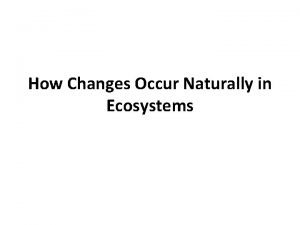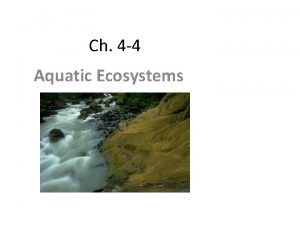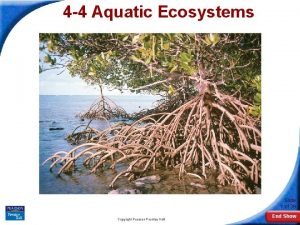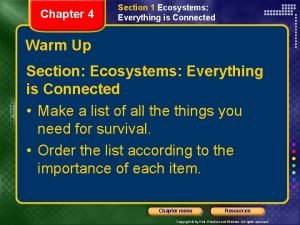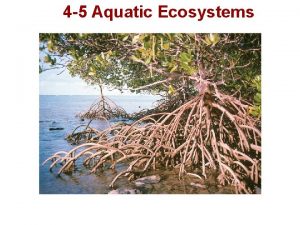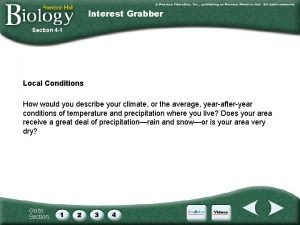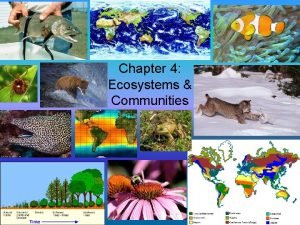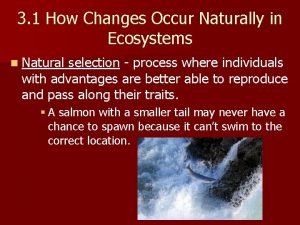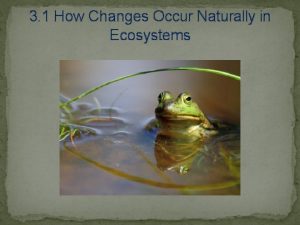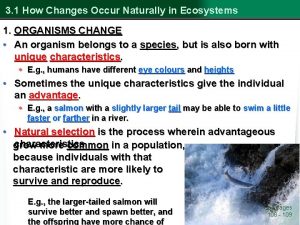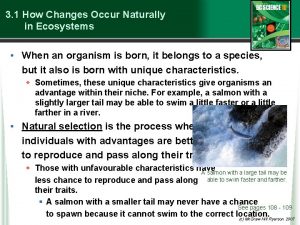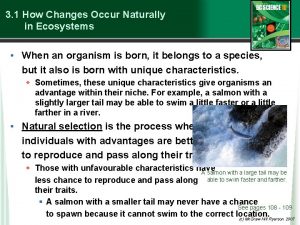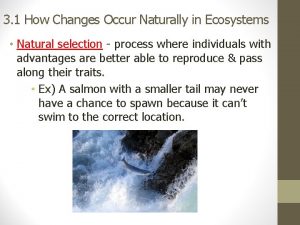HOW CHANGES OCCUR NATURALLY IN ECOSYSTEMS Section 3













- Slides: 13

HOW CHANGES OCCUR NATURALLY IN ECOSYSTEMS Section 3. 1

NATURAL SELECTION • Process where individuals with advantages are better able to reproduce and pass along their traits. • A salmon with a smaller tail may never have a chance to spawn because it can’t swim to the correct location

EXAMPLE • The finches of the Galapagos Islands. • There are 13 species on the island

EXAMPLE (CON’D) • All the species are descended from one finch species on the mainland. • Each species has unique characteristics that allows them to thrive in their own niche, and not compete with other finches for resources. • Adaptive radiation - a form of natural selection when many different species appear from one original species.

ECOLOGICA L SUCCESSIO N Changes in the biotic characteristics in an area over time.

1) STEPS OF PRIMARY SUCCESSION A. Starts with bare rock. B. Wind carries spores of lichens that can survive on bare rock. C. Weathering breaks down rock soil begins to form

PRIMARY SUCCESSION (CON’D) e. Pioneer species make/improve soil f. other plants grow g. animals appear h. form a mature community (stable and change slowly)

PIONEER SPECIES • Pioneer species are the first organisms to survive and reproduce • e. g. Lichens and mosses

2. SECONDARY SUCCESSION • When an area already has soil, but has had a disturbance like a forest fire or clearcut. • Happens more quickly than primary because there already seeds, insects, worms etc. in the soil.

• DISTURBANCES THAT MIGHT CAUSE SECONDARY 1. Flooding SUCCESSION • Leads to soil erosion, spread of pollutants and harmful bacteria associated with sewage • Climate change and global warming may be increasing incidents of flooding. • A tsunami occurs when huge waves, from large earthquakes, flood coastal areas.

2. DROUGHT • Plants die with no water. Just come to my house in the summer and look at my lawn!

3. INSECT INFESTATION • Most insects are helpful, but when normal conditions change, infestations can occur. • Example: Mountain Pine Beetle: Usually it is not a problem. . . it helps remove old trees, but. .

PINE BEETLE • …In our forests there a lot of old trees, the climate is warming, and the bugs are not dying in the winter. • Pine beetle has blue stain fungus in its mouthparts, which it transmits to the trees (symbiotic relationship). • Fungus slows down resin production on trees so the beetle can eat the tree more easily.
 What is succession
What is succession Changes in latitudes, changes in attitudes meaning
Changes in latitudes, changes in attitudes meaning What is a phisical change
What is a phisical change Transitional aquatic ecosystems
Transitional aquatic ecosystems Section 3 energy in ecosystems
Section 3 energy in ecosystems 4-4 aquatic ecosystems
4-4 aquatic ecosystems 4-4 aquatic ecosystems answer key
4-4 aquatic ecosystems answer key Section 1 ecosystems everything is connected answer key
Section 1 ecosystems everything is connected answer key Section 4-4 aquatic ecosystems
Section 4-4 aquatic ecosystems Section 1 energy flow in ecosystems
Section 1 energy flow in ecosystems Section 4-2 what shapes an ecosystem answer key
Section 4-2 what shapes an ecosystem answer key Section 4-4 aquatic ecosystems
Section 4-4 aquatic ecosystems Describe freshwater
Describe freshwater Chemical reactions section 1 chemical changes
Chemical reactions section 1 chemical changes
